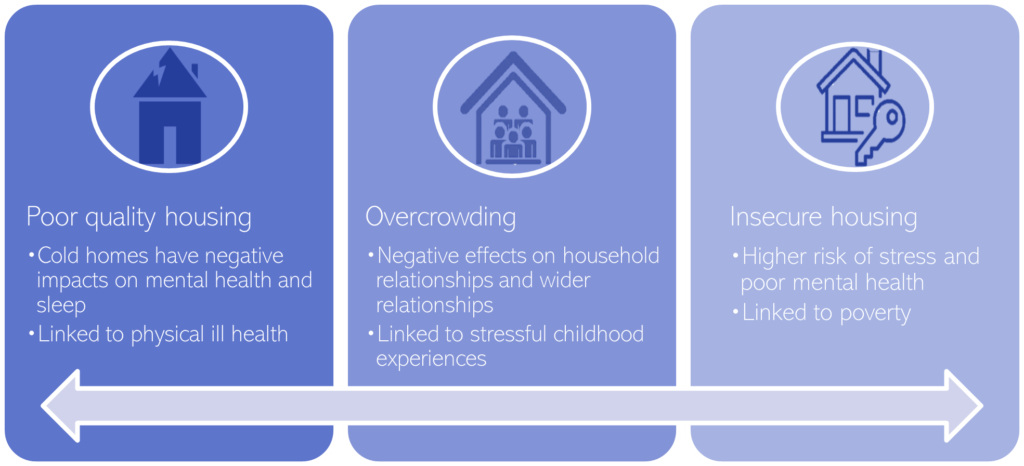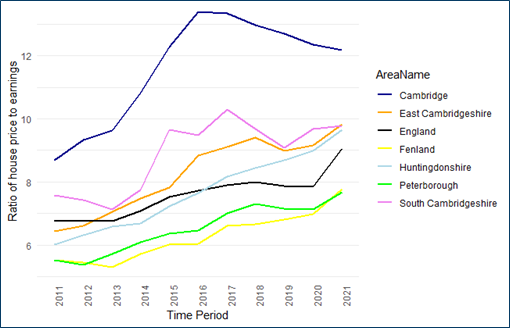Housing, Homelessness and Environmental Justice
Homelessness and poor quality housing are risk factors for mental health problems: whereas stable, good quality housing is a protective factor and can be a vital part of recovery from mental illness (4).
Why are housing and environmental justice important to mental health?
-
-
-
-
-
-
- Housing problems are key stressors for poor mental health: 1 in 5 people have experienced mental health issues because of housing problems (49).
- Stable, good quality housing is a protective factor for mental health and can be a vital part of recovery from mental illness (4). However, poor quality housing can have a detrimental impact on mental health.
-
-
-
-
-

Figure 14: Summary of housing issues
-
-
-
-
-
-
-
- Living in an overcrowded house in childhood is associated with an increased risk of stressful childhood experiences and deprivation; and is linked to a greater risk of depression in adulthood (11).
- Living in a home with limited space can negatively impact mental health by hindering privacy and family relations, and by preventing people from socialising with others outside of their household (50).
- A lack of appropriate accommodation is a well-known barrier for people being discharged from inpatient psychiatric care (51).
-
-
-
-
-
-
Homelessness
-
-
-
-
-
-
- Compared with the general population, people experiencing homelessness are twice as likely to have a common mental health condition, and up to 15 times from likely to experience psychosis (4).
- People experiencing homelessness are also over 9 times more likely to complete suicide (4).
- Rates of mental health conditions are likely to be higher among people caught in the ‘revolving door’ between hostels, prison, hospitals and the streets (4).
- The inequalities in mental health faced by people experiencing homelessness are explored in more detail in Chapter 2.
-
-
-
-
-
Physical environment
-
-
-
-
-
-
- Access to green space is consistently linked to greater wellbeing and improved mental health, as well as acting as a buffer for the effects of mental distress (52).
- Green space has positive impacts on emotional and behavioural difficulties in young people (53).
- Moving to an area with more green space produces long-term improvements to mental health (54); though the relationship between green space and mental health may be moderated by factors such as the safety of local parks (55).
- Green space can help to reduce health inequalities; yet poorer communities generally have less access to parks (56)
-
-
-
-
-
What is the national picture?
-
-
-
-
-
-
- Four million homes in England do not meet the Government’s Decent Homes Standards, with privately rented homes being the most likely to fall below these requirements (57).
- To meet this standard, homes must meet minimum standards for safety, provide reasonable ‘thermal comfort’, be in a reasonable state of repair, and have reasonably modern facilities.
- Renters have lower levels of life satisfaction and higher levels of anxiety than those who own their home (57). This is likely to be linked to poverty rates: a third of all private renters live in poverty, almost half (46%) of whom are pulled into poverty by their housing costs (42).
- Around 3% of houses in the East of England are overcrowded (58). A household is overcrowded if it has fewer bedrooms than it needs to avoid undesirable sharing, based on the age, gender and relationship of household members (58).
- However, households which are Bangladeshi (24%), Pakistani (18%), Black African (16%) have much higher rates of overcrowding than White households (2%) (58).
- Four million homes in England do not meet the Government’s Decent Homes Standards, with privately rented homes being the most likely to fall below these requirements (57).
-
-
-
-
-
What is the local picture?
-
-
-
-
-
-
- Housing ownership is increasingly out of reach across C & P, particularly in Cambridge.
-
-
-
-
-

Figure 15: Affordability of housing ownership across C & P over time. Data source: (44)
-
-
-
-
-
-
- There has been a notable increase in number of households on local authorities’ waiting lists for housing in Peterborough since 2018, although in Cambridgeshire, waiting lists have decreased over this time (59).
- The proportion of adults who receiving support from secondary mental health services recorded as living in appropriate accommodation was generally higher than the English average in C & P over the past 5 years (44).
-
-
-
-
-

Figure 16: Adults in contact with secondary mental health services who live in stable and appropriate accommodation, 2020/21. Data source: (44)
homelessness
-
-
-
-
-
-
- Peterborough was one of the top 10 local authorities in England by number of people sleeping rough on a single night (36 people) in 2021 (60).
- In contrast to this, the proportion of households in temporary accommodation is below the national average across C & P (44).
- The most common cause for households owed a relief duty after losing their last settled home is domestic abuse (61), which has a substantial impact on the mental health of both the victims of violence and other members of the household.
- In 2021/22, 155 households in Cambridgeshire and 171 in Peterborough were owed relief due to domestic abuse (61).
-
-
-
-
-
environmental justice
-
-
-
-
-
-
- The Future Parks department has recently developed an Environmental Justice Index to measure the distribution of environmental inequalities (62). Fenland and Huntingdon have the greatest levels of environment injustice, as well as urban areas in Peterborough and North Cambridge.
- This index combines 10 measures, spanning health and deprivation, environmental risk factors (covering air and noise pollution, urban heat risk, and flood risk), and access to nature and green space.
-
-
-
-
-

-
-
-
-
-
-
- Figure 17: Average environmental justice index scores across C & P, where higher scores indicate greater levels of injustice. Source: Cambridgeshire and Peterborough Future Parks Programme 2022
-
-
-
-
-
Additional resources
- The local data pack gives an overview of key data and trends
- The Centre for Ageing Better’s report on How poor-quality homes have contributed to the pandemic
- The Health Foundation’s Evidence Hub on housing
- The Local Government Association’s report The impact of homelessness on health: a guide for local authorities
- A summary of research showing The importance of greenspace for mental health
- The NHS report Healthy foundations: integrating housing as part of the mental health pathway highlights the importance of housing to mental health recovery
- NIHR summaries on the importance of housing and environmental factors to public mental health
- Further local data on housing, supported housing and the environment
References
Full list of references can be found here
- Shelter. The impact of housing problems on mental health. 2017.
- Thomson H, Thomas S, Sellström E, Petticrew M. Housing Improvements for Health and Associated Socio‐Economic Outcomes: A Systematic Review. Campbell Systematic Reviews. 2013;9(1).
- NHS Confederation. Healthy foundations: integrating housing as part of the mental health pathway [Internet]. 2022 [cited 2022 Oct 5]. Available from: https://www.nhsconfed.org/publications/healthy-foundations-integrating-housing-part-mental-health-pathway
- Barton J, Rogerson M. The importance of greenspace for mental health. BJPsych Int. 2017;14(4).
- Vanaken GJ, Danckaerts M. Impact of green space exposure on children’s and adolescents’ mental health: A systematic review. Vol. 15, International Journal of Environmental Research and Public Health. 2018.
- Alcock I, White MP, Wheeler BW, Fleming LE, Depledge MH. Longitudinal effects on mental health of moving to greener and less green urban areas. Environ Sci Technol. 2014;48(2).
- Mueller MAE, Flouri E. Urban Adolescence: The Role of Neighbourhood Greenspace in Mental Well-Being. Front Psychol. 2021;12.
- Public Health England. Improving access to greenspace A new review for 2020 [Internet]. 2020 [cited 2022 Oct 3]. Available from: https://assets.publishing.service.gov.uk/government/uploads/system/uploads/attachment_data/file/904439/Improving_access_to_greenspace_2020_review.pdf
- DLUHC. English Housing Survey [Internet]. 2021. Available from: https://www.gov.uk/government/statistics/household-resilience-study-wave-3
- MHCLG. Overcrowded households [Internet]. Ministry of Housing, Communities and Local Government. 2020 [cited 2022 Oct 5]. Available from: https://www.ethnicity-facts-figures.service.gov.uk/housing/housing-conditions/overcrowded-households/latest
- DLUHC. Local authority housing statistics data returns for 2020 to 2021 [Internet]. 2022 [cited 2022 Oct 4]. Available from: https://www.gov.uk/government/statistical-data-sets/local-authority-housing-statistics-data-returns-for-2020-to-2021
- DLUHC. Rough sleeping snapshot in England: autumn 2021 [Internet]. 2022 [cited 2022 Oct 4]. Available from: https://www.gov.uk/government/statistics/rough-sleeping-snapshot-in-england-autumn-2021/rough-sleeping-snapshot-in-england-autumn-2021
- DLUHC, MHCLG. Live tables on homelessness [Internet]. 2022 [cited 2022 Nov 16]. Available from: https://www.gov.uk/government/statistical-data-sets/live-tables-on-homelessness
- Cambridgeshire and Peterborough Future Parks Programme. Developing an Environmental Justice Index for Cambridgeshire. 2022.
